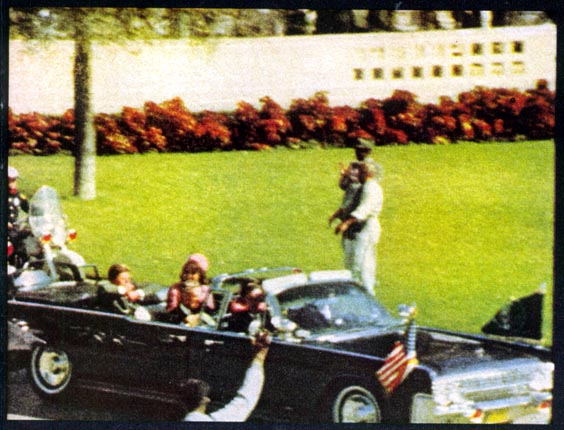
Everyone knows that if you take a photo of something moving, it will come out blurry on the photo.
During the assassination, JFK’s limousine was moving down Elm Street as Abraham Zapruder was filming.
Photographers know that there are two ways to photograph a moving car without it coming out blurry:
Zapruder’s camera had a shutter speed that was fixed at 1/40 of a second. This was too slow to stop the car from being blurry.
Zapruder did move his camera to follow the limousine as it traveled down Elm Street. In most of the frames, the limousine is quite sharp. This means that the background objects are blurry, because the camera is sweeping past them:

A frame of the film where the limo occupants are sharp and the people in the background are blurry
If you do careful measurements and physics calculations, you find that all of the objects in almost all of the frames of the Zapruder film are correctly blurred, like this one.
But in their rush to publish something quickly, the forgers made mistakes. In the weeks after the assassination, Life magazine published nine color photos that they said came from “an eight millimeter film of the assassination” (they never mentioned Zapruder’s name). Two of these photos are incredibly sharp:

One frame published in the Life JFK Memorial Edition, undated, but around December 13, 1963

Another frame published in the Life JFK Memorial Edition
We will concentrate on this second photo. Notice how sharp the limousine and the motorcycle are, including JFK, his wife Jackie, Governor of Texas John Connally (sitting in front of JFK), and the cop on the motorcycle. Notice the keyhole below the handle of the front door of the limousine.
Now look at the man in the foreground, at the bottom of the frame, with his fingers in a “V” shape. To his left you can see the edge of a black umbrella (just above the back wheel of the limo). In the background you can see a tree. The leaves are sharp against the shaded trunk. Look at the red shrubs behind. You can see many bright spots. Look also at the two men (who, strangely, aren’t looking at the President at all!). Compare them to the people shown in the frame at the top of this page.
Just by looking at it, you can see that there is something wrong with this photo. But we can also use the laws of physics to check that it is impossible. This is the sort of test that would be used in a court of law to prove that the film is a forgery.
The first thing we need to know is how far the limousine moved while the camera shutter was open. We can work this out by looking at the film frames before and after this frame on the film, as it was later published in 1998:

The frames before and after the frame shown above
(Note that these 1998 images show a lot of mold damage.) If we carefully follow along with one object on the limo, like one of the bright reflections on the “roll bar,” we can see how much the limo moves from frame to frame:

Following a fixed spot on the limo
The shutter on Zapruder’s movie camera was open about 46% of the time. This lets us figure out how far the limo moved while the shutter was open for one frame:

The movement of the limo while the shutter was open
Either the limo (and everyone in it), or the whole background (and the man and umbrella in the foreground), or some combination of the two, should be blurred by this much. It obviously isn’t!
To see this most clearly, imagine the best possible scenario for those who believe the Life image to be authentic: that the camera was actually panning half as fast as it should be to follow the limo. Then the background would be blurred by half of the movement shown above (falling behind by moving to the left, as seen by the camera), and the limo would be also be blurred by half of the movement above (moving ahead to the right, as seen by the camera). In other words, the whole image would be blurred by half of the movement shown above. This is easy to do using a modern computer:

What the frame should look like if the camera was “half-following” the limo
That’s obviously not what we see in Life!
Some people might ask: could Life magazine have just “sharpened” the image before publication?
It was possible to sharpen an image in 1963 using “unsharp masks,” the film forerunner of today’s digital equivalent, although it would be extremely difficult to remove motion blur of this size (using either method). However, the question is moot: since 2003 researchers have gained access to higher quality copies of the “camera original” Zapruder film in the National Archives. It shows the same thing, proving that Life did not “sharpen” these images.
Rather, we are left to conclude that the frame shown in Life is a high-quality forgery, created by cutting and pasting together real photographs and film frames of the assassination, before the forgers knew what the final “timeline” for the film would be—causing them to not realize that this frame was too sharp for the camera that Zapruder was supposed to have used, and should have been motion-blurred before they released it. Once published in Life and mailed out in millions of copies to subscribers, the toothpaste was out of the tube! This irrefutable evidence of forgery is now there for all of us to see, right there on the printed page.
The blur mistake